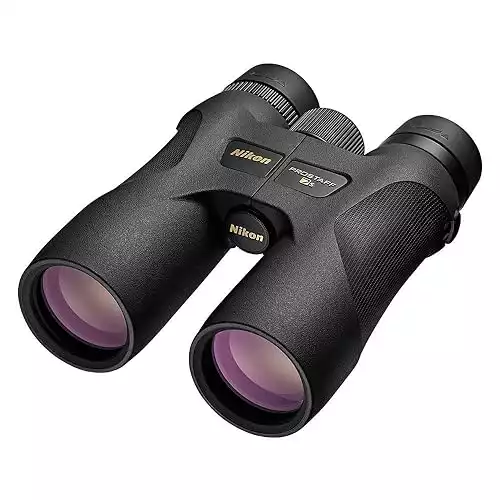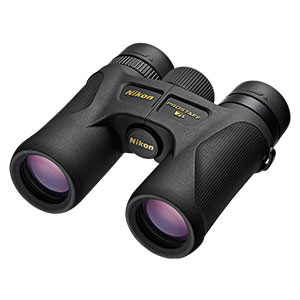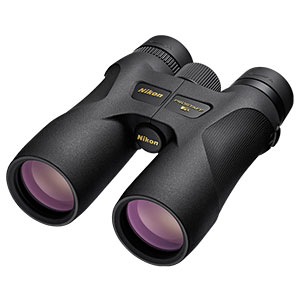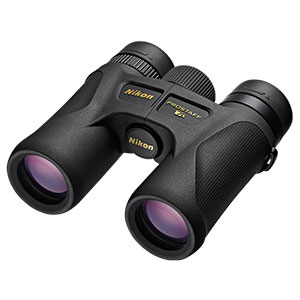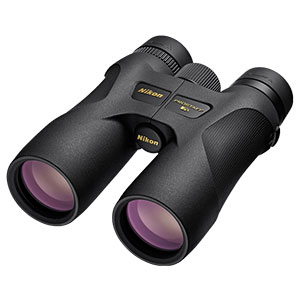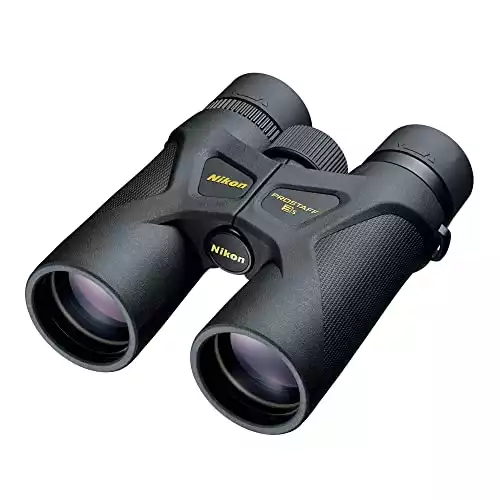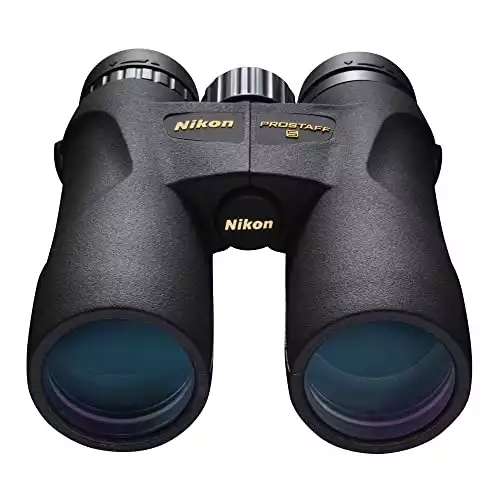In a Nutshell:
Nikon Prostaff 7S Binoculars offer incredible value for quality viewing performance. This model is compact and durable, with multiple magnifications that produce a crisp, clear picture of moving objects. It’s ideal for hunting, birding, hiking, and casual outdoor use.
Clarity
Portability
Magnification
Durability
Overall Rating
5/5
Benefits
Drawbacks
Recommended For: Hunting, birding, hiking, and casual outdoor use.
Whether you’re a birdwatcher, hunter, or sports enthusiast, a quality pair of binoculars makes all the difference in your viewing experience.
But there are plenty of factors to consider to ensure you’ve got the right set for the job.
In this Nikon Prostaff binoculars review, we take an in-depth look at a reasonably priced line of high-performance binoculars. Let’s dive in!
Nikon Prostaff 7S Design Overview
Nikon is a global name when it comes to all things optics, and with the Nikon Prostaff binoculars series, that reputation for innovation and excellence is upheld beautifully.
Their Nikon 7s Prostaff line is the focus of our review today, as we look at what it has to offer enthusiasts, starting with the design.
It’s a user-friendly model manufactured from the highest quality materials. It’s also surprisingly affordable for what it can do, costing a modest $240 compared to other expensive models with a similar feature set.
There are a few different models in the Prostaff 7s line with varying magnifications and objective lens sizes.
This includes:
We’ll go over magnification in more detail later on. If you’re browsing these models, understand that the numbers on binoculars do not have anything to do with the design and features—you get the same great build across the board.
The Prostaff 7s is offered in two colors: black and camouflage. The camo coloring makes it obvious that this model is designed with hunters and wildlife lovers in mind. But how does the performance stack up?
With Nikon Prostaff 7s 10×42 reviews buzzing about the crisp, clear image, impressive stability, and wide field of view, anyone out in the field or on the hunt will probably have their visual expectations fulfilled.
And here’s why…
Portability
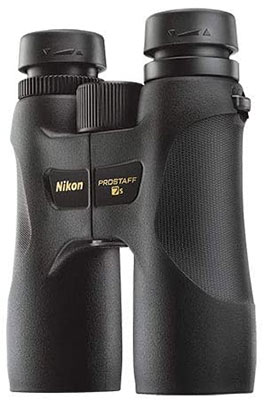
Portability is an important factor to consider with binoculars design, especially if you’re using them for hunting, hiking, paddling, or birdwatching.
You need to be able to move fast, grab your binos in a pinch, and adjust them before the object on the receiving end (let’s say a deer) notices your movements and books it.
The smaller the binoculars are, the easier it is to carry, which is another reason why the ProStaff 7s line is an ideal choice.
It’s considered compact and lightweight at only 6” long and 5” wide and only weighs 23.5-oz.
But compared to other binoculars in the compact range, we ranked the Prostaff 7 as average.
While it is compact enough to slide seamlessly into your hiking pack without hogging too much room, it’s a bit oversized for hunting if you also carry a bunch of other items.
A chest harness might keep the binoculars out of the way but remain close enough so you can grab them quickly when needed.
The size is hardly a deal-breaker, though, since the trade-off for a larger size is a clearer image.
Durability
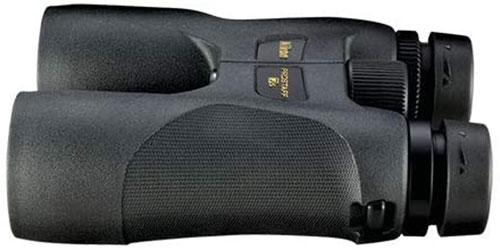
The Prostaff 7s line was made for the outdoors, making durability another huge factor for your consideration.
Whether you’re racing through the woods to catch a glimpse of that Yellow-Bellied Warbler or down on the ground spying on that buck, binoculars need to be sturdy, waterproof, and fog-proof.
This is where the materials come into play, and we’re happy to report that the Prostaff 7s checks all of the boxes for long-lasting quality.
The binoculars arrive in a plastic case with a carrying strap, complete with lens caps for the optical lens and eyepieces to ensure they stay in pristine condition when not in use.
You won’t find flimsy tape or gunky glue on the body itself. The seams are invisible, and the seals have been applied expertly, so not a drop of water or kiss of fog will breach the fragile optics.
Nikon 16003 Prostaff 7s Performance Capabilities
Next up, we take a look at the more intricate inner workings of the Nikon Prostaff 7s compact binoculars and how they perform out in the field.
Magnification
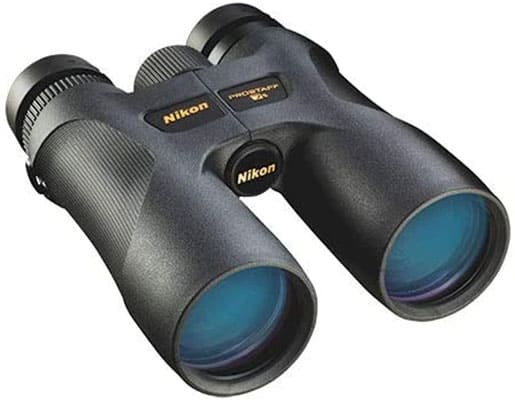
The magnification is one of the areas where the Prostaff 7s shines compared to other binoculars, especially when maintaining stability while following a moving object.
The Nikon Prostaff 7s 10×42 and Nikon Prostaff 7s 10×30 binoculars offer incredible magnification for the device’s dimensions, making these particular models suitable for hunting.
But to watch an object at the maximum magnification with barely any shakiness or amplified hand movements? This is a common occurrence with many 10x binoculars that the Prostaff 7s tackles with finesse.
For birdwatching and casual use, the Nikon Prostaff 7s 8×30 and Nikon Prostaff 7s 8×42 binoculars take center stage, giving enthusiasts the same stability and brightness but with a wider field of view that makes it easier to spot birds.
Clarity
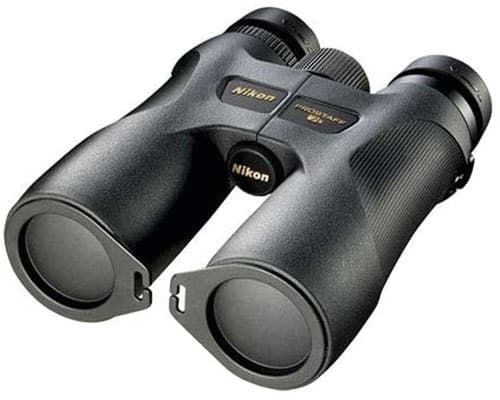
Imagine you’re lifting the Prostaff 7s eyecups to your eyes, and the object you just saw as a dot half a mile away is suddenly perfectly crisp, clear, and right in front of you.
That’s the magic of the Prostaff 7s series and its wide field of view that allows users to scope out a large area without any tedious adjusting.
That’s another point that sets this model apart from other binos on the market, as it’s a common practice to adjust focus constantly.
Not with the Prostaff 7s! It does users better with its 6-degree view, which means you will rarely have to move your face or even your body to another location for improved clarity.
Whether you’re hunting, birding, or exploring nature, you can expect top-notch viewing, although one glitch we did experience was sunspots in the field of vision.
This only occurred while looking at objects in direct sunlight. It may bother perfectionists, but we can’t complain about the stable performance you get for the price.
Ease of Adjustment

Since the magnification and clarity are already down pat with the Prostaff 7s, you shouldn’t need to adjust much.
But for those times when a toggle is in order, a strategically placed knob makes it easy to adjust the diopter and focus with little more than a one-handed twist, freeing your other hand to make itself useful when you are out in nature.
For those who wear glasses, you’ll love that all you have to do is twist the eyecups, and in a few clicks, you have more control over how you view—simple as can be.
Nikon Prostaff 7s Binoculars Pros vs. Cons
PROS
CONS
The Nikon Prostaff 7s binoculars are compact and precise without any of the fuss—all for a price that we can stand behind.
The wide variety of magnification numbers give hunters, birders, and casual users an enjoyable experience outdoors without having to worry about a bit of rain, fog, or a bumpy ride causing damage.
But the big win comes with the roof prisms that provide an impeccable viewing experience. Images—still or moving—are always clear and bright, without any shakiness or amplification at the max magnification.
This kind of stability is rare to find with binoculars in this modest price range, making the Prostaff 7s a true gem.
The 6-degree field of view also makes it easy to focus on a large area and not miss a beat. This, along with the stable magnification and clarity, makes it, so that very little adjusting is needed to achieve an optimal focus.
This is especially important when you’re out in nature, where the less you move, the better. You won’t have to worry about scaring off wildlife while gazing through these binoculars.
As you can see, the drawbacks are few and minimal. Nikon delivers yet another well-designed device that you can rely on to give you quality performance and a user-friendly experience.
We Recommend the Nikon Prostaff 7s Binoculars for…
Nikon Prostaff 7S Binoculars Nikon Prostaff Warranty
Nikon offers a few different options under their warranty program. You can read the fine print here.
- Lifetime Limited Warranty: This applies to the optical system components.
- Seven-Year Limited Warranty: This applies to the non-optical system components.
- One-year Limited Warranty: This applies to electronic components.
Comparable Products
The Nikon Prostaff series features a few different binoculars that vary slightly in performance to the popular 7s line. Let’s see how they compare!
Recommended For: Outdoor use. It is more lightweight than the Prostaff 7s.
The Nikon Prostaff 3s 8 x 42 and Prostaff 3s 10 x 42 binoculars also boast a high caliber performance suitable for outdoor use, especially since it is more lightweight than the 7s.
It also costs less. But bear in mind, you get what you pay for.
The Prostaff 7s lens is fully multi-coated, and the prisms are phase-correction coated with high-quality material, unlike the 3s.
The 3s series features fewer coatings and no phase-correction coating.
This is important, affecting the overall optical performance. So while the Prostaff 7s does cost a bit more, it’s worth the quality of the view if you’re serious about your binoculars.
Recommended For: Low-light settings like night hunting or stargazing,
Both the Prostaff 5s and 7s series offer users an impeccable view for outdoor use, but the 7s series is geared more towards daytime viewing, which is where the 5s sets itself apart.
The Nikon Prostaff 5s 10 x 50 makes it possible to get that crisp, clear image this series is known for, but in low-light settings.
So, if you’re into night hunting or stargazing, the Prostaff 5s might be the right pick for you.
Nikon Prostaff Binoculars Review Conclusion
To conclude this Nikon Prostaff binoculars review, choosing the right pair of binoculars isn’t just about the price. You need to understand how well they perform in terms of magnification and clarity.
The 7s series is an excellent choice for quality and value. There are several magnifications to choose from, with sturdy, weatherproof materials that provide a crisp, clear picture for hunting, birding, hiking, and casual use.
References & Resources:
- Nikon, Official Brand Website.
- Why Binoculars?, Research Gate.
- Using Binoculars, Astronomy.
- Why Do People Look Into Space With Telescopes but Not Binoculars?, The Conversation.
